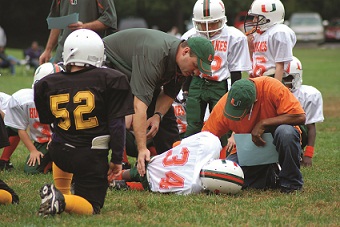

Taking steps to prevent abuse is vital component of preparing for youth sports activities; many associations and organizations have guidelines in place to assist event planners, coaches and volunteers in the development of a prevention plan. Another helpful source of information is the Centers for Disease Control and Prevention (CDC) website, found at www.cdc.gov.
The CDC has developed a packet of information titled “Preventing Child Sexual Abuse Within Youth-serving Organizations: Getting Started on Policies and Procedures” created for youth-serving organizations as they begin to adopt prevention strategies for child sexual abuse. The guide identifies six areas of concern, including: screening and selecting employees and volunteers; guidelines on interactions between individuals; monitoring behavior; ensuring safe environments; responding to inappropriate behavior and allegations of abuse; and training in sexual abuse prevention.
In addition to implementing an abuse prevention plan, sports organizations should consider adding sexual abuse and molestation (SAM) coverage to their general liability coverage when purchasing insurance for their organizations and events. Purchasing coverage specifically developed to protect sports organizations is important financial protection and provides liability coverage for sums the insured becomes legally obligated to pay as damages because of loss arising out of actual or threatened sexual abuse or molestation. This coverage is different from SAM defense cost reimbursement coverage, which simply pays for defense costs the covered organization incurs. Sexual abuse and molestation coverage is offered by some insurance providers when purchasing commercial general liability coverage, often as optional coverage.

• Products-completed operations generally protects the organization from claims related to the manufacture or sale of products to the public. It may cover the seller's liability for losses or injuries to a buyer, user or bystander caused by a defect or malfunction of the product). One common area of concern for sports organizations is concession stands that carry the potential for food-related illness claims.
• Personal and advertising injury (covers an injury to a third-party brought about by the insured business advertising its goods and services, usually by copyright or trademark infringement or due to libel, slander, or invasion of privacy)
• Legal Liability to Participants protects against bodily injury liability claims brought by persons participating in covered sports activities. Professional liability provides protection for claims arising out of the rendering or failure to render instruction, demonstration, direction or advice relating to the sports activity.
• Inland marine coverage, sometimes called equipment and contents coverage, provides coverage for direct loss or damage to sports equipment, field maintenance equipment, concession stand equipment and portable storage sheds.
• Medical payments for participants coverage pays medical and dental expenses incurred by a participant when accidental injury occurs while participating in covered sports activities (this coverage is usually on an excess basis, after all other medical coverage available to the participant has been exhausted). This coverage may be included as a coverage offered within the general liability policy or as a separate participant accident policy; make sure to review coverage options to verify where (or if) this insurance is provided in your insurance quote.

An additional insured is an entity which has an insurable interest for claims arising out of your negligence as the named insured. A certificate of insurance is provided to the additional insured providing proof of coverage. If you are an event organizer, the venue/facility may require you to show proof of liability and list them as an additional insured to your policy. This will protect you, the named insured, and the venue/facility for defense and indemnity costs (if policy limits have not been exhausted) brought by a third party (spectators) and/or by participating teams.
This is a very common request and, unfortunately, can sometimes be a source of added costs from insurance providers who charge an extra fee for certificates of insurance, sometimes as much as $25 to $50 for each certificate requested. This is an important financial consideration for sports organization when choosing an insurance provider. Remember that all additional insureds added to the policy share the limits on the policy, which can impact the dollar amount of coverage available to the sports organization that purchased the policy (the named insured) in the event of a large claim.
The policy “limit” is the dollar amount of protection purchased and will receive when there is a claim. For example, you may choose to buy a policy that offers a $2,000,000 occurrence limit with a $4,000,000 aggregate limit. This means that your limit for an individual incident is $2M with a total limit of $4M for all incidents occurring while the policy is in effect. Facilities or tournament hosts may mandate minimum limits, which can vary. Before purchasing coverage, be sure to check any contract or agreement you sign for insurance requirements.
 When choosing an insurance provider, always ask about the financial stability of the carrier; a high rating (A or better) by an independent rating company such as A.M. Best Company is the safest choice. Also, choosing a carrier that is “admitted” (licensed) is preferable because choosing an insurance company that is non-admitted (called surplus lines) may require you to pay extra fees or taxes.
When choosing an insurance provider, always ask about the financial stability of the carrier; a high rating (A or better) by an independent rating company such as A.M. Best Company is the safest choice. Also, choosing a carrier that is “admitted” (licensed) is preferable because choosing an insurance company that is non-admitted (called surplus lines) may require you to pay extra fees or taxes.
Of course, experience is also a factor. Companies familiar with the unique risks associated with sports organizations and events will be able to accurately price coverage and more importantly, provide prompt and reliable claims handling services. You may also want to look for convenient services such as the ability to apply and purchase coverage online, as opposed to completing a paper application that must be mailed and approved before coverage is in force.
Purchasing the right type and amount of insurance provides peace of mind when preparing for your next event. Choose the right liability coverage for your sports organization and you’ll be able to focus on other details, knowing that you’ve got the coverage you need.

